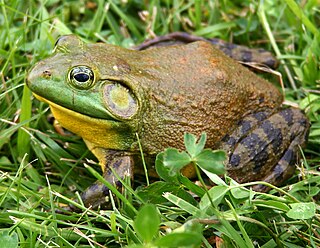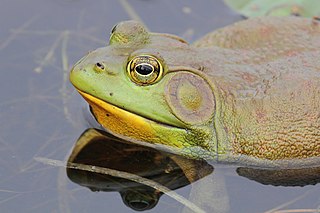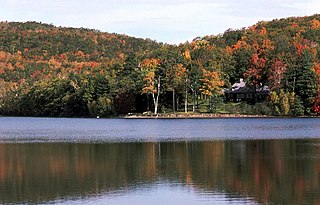
The American bullfrog, often simply known as the bullfrog in Canada and the United States, is a large true frog native to eastern North America. It typically inhabits large permanent water bodies such as swamps, ponds, and lakes. Bullfrogs can also be found in manmade habitats such as pools, koi ponds, canals, ditches and culverts. The bullfrog gets its name from the sound the male makes during the breeding season, which sounds similar to a bull bellowing. The bullfrog is large and is commonly eaten throughout its range, especially in the southern United States where they are plentiful.

Lithobates pipiens formerly Rana pipiens, commonly known as the northern leopard frog, is a species of leopard frog from the true frog family, native to parts of Canada and the United States. It is the state amphibian of Minnesota and Vermont.

The Credit River is a river in southern Ontario, which flows from headwaters above the Niagara Escarpment near Orangeville and Caledon East to empty into Lake Ontario at Port Credit, Mississauga. It drains an area of approximately 1,000 square kilometres (390 sq mi). The total length of the river and its tributary streams is over 1,500 kilometres (930 mi).

Lithobates sylvaticus or Rana sylvatica, commonly known as the wood frog, is a frog species that has a broad distribution over North America, extending from the boreal forest of the north to the southern Appalachians, with several notable disjunct populations including lowland eastern North Carolina. The wood frog has garnered attention from biologists because of its freeze tolerance, relatively great degree of terrestrialism, interesting habitat associations, and relatively long-range movements.

The pickerel frog is a small North American frog, characterized by the appearance of seemingly "hand-drawn" squares on its dorsal surface.

The Australian green tree frog, also known as simply green tree frog in Australia, White's tree frog, or dumpy tree frog, is a species of tree frog native to Australia and New Guinea, with introduced populations in the United States and New Zealand, though the latter is believed to have died out. It is morphologically similar to some other members of its genus, particularly the magnificent tree frog (R. splendida) and the white-lipped tree frog (R. infrafrenata).
The Florida bog frog is a rare species of frog found only in western Florida.

Lithobates sphenocephalus or Rana sphenocephala, commonly known as the southern leopard frog, is a medium-sized anuran in the family Ranidae. The southern leopard frog is one of the 36 species of the Ranidae family found in North America. It is native to eastern North America from Kansas to New York to Florida. It is also an introduced species in some areas. This species lives in cool, clear water in the north, whereas in the south it occurs in warmer turbid and murky waters of coastal and floodplain swamps, twilight zones of caves, and abandoned mines.

Lithobates, commonly known as the bullfrogs, is a genus of true frogs, of the family Ranidae. The name is derived from litho- (stone) and the Greek bates, meaning one that treads on rock, or rock climber. As presently defined, it includes many of eastern North America's most familiar aquatic frog species, including the American bullfrog, green frog, and the leopard frogs.
The Patzcuaro frog is a species of frog in the family Ranidae. Within the former, broadly defined genus Rana, it belongs to the Rana montezumae subgroup of the Rana pipiens complex. It is endemic to Michoacán state, Mexico, where it is locally known as rana de Pátzcuaro. It occurs in Lake Pátzcuaro, Lake Cuitzeo, and the surrounding streams in Río de Morelia.

The river frog is a species of aquatic frog in the family Ranidae. It is endemic to the southeastern United States. Its natural habitats are temperate rivers, swamps, freshwater lakes and freshwater marshes. It is threatened by habitat loss.

Lithobates clamitans or Rana clamitans, commonly known as the green frog, is a species of frog native to eastern North America. The two subspecies are the bronze frog and the northern green frog.

Mont-Saint-Bruno Provincial Park is a small national park of Quebec located near the municipality of Saint-Bruno-de-Montarville, 15 kilometres (9.3 mi) to the east of Montréal on the south shore of the Saint Lawrence River. The park, with an area of 8.84 square kilometres (3.41 sq mi), notably includes Mont Saint-Bruno, one of the Monteregian Hills which peaks at 218 metres (715 ft). The mountain is shared with the Ski Mont Saint-Bruno ski resort, a quarry and a small Canadian Forces training camp. Despite its relatively small size, the mountain is known for its rich fauna and flora. Situated at the heart of the old signory of Montarville, its many lakes have permitted the construction and exploitation of many water mills, contributing to the region's economical success. A building from one of those mills, the "Vieux Moulin", still stands to this day and is used as a rest area for skiers and hikers in different seasons.

The Atlantic Coast leopard frog is a species of amphibian that is endemic to the United States. As a member of the genus Ranasensu lato, it is classified as a true frog, with typical smooth skin and a narrow waist. Its range stretches along the northern part of Eastern Seaboard, from Connecticut to North Carolina. The species takes its common name from the speckles on its legs and back reminiscent of a leopard pattern.
Countergradient variation is a type of phenotypic plasticity that occurs when the phenotypic variation determined by a biological population's genetic components opposes the phenotypic variation caused by an environmental gradient. This can cause different populations of the same organism to display similar phenotypes regardless of their underlying genetics and differences in their environments.















